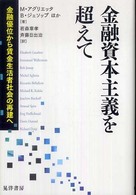- ホーム
- > 洋書
- > ドイツ書
- > Humanities, Arts & Music
- > Arts
- > history of arts
Description
(Text)
Ancient ceramics are a mainstay of archaeological assemblages, second to nothing in their sheer number of finds at almost all sites and in all cultures pertaining to the last ten thousand years, and as such unsurpassed in their information potential. The authors summarise the development of ceramic technology throughout the Old World during Neolithic/ Chalcolithic/Bronze Ages. They base their study on mineralogical and chemical analyses of typical pottery fragments collected by the first author, Walter Noll during the last quarter of the past century. Readers and reviewers of the original German edition have often suggested the need for an updated English edition ofthis important work, finally undertaken by Robert B. Heimann. Chapters one to four comprehensively describe - in a very readable way - the principles of ancient ceramic technology largely based on Walter Noll's own work, demonstrating the chemical, mineralogical and materials science background of this subject matter. Chapter 5 discusses the results of Noll's analytical work on a limited number of ancient ceramic objects from Mesopotamia, Anatolia, Iran, Sistan, the Indus Valley, and Egypt to complement the scientific foundation laid down in the first chapters. The authors describe and explain in an intuitive and plausible way the sometimes very complex and erudite physico-chemical relationships among minerals during processing of clays and the firing of ceramics. Thus, they unravel the intricate interplay of the mineralogy of clays, and their processing, shaping, firing and painting to arrive at ceramic masterpieces handed down to us from the distant past. In a logical manner, the authors present many procedural details about the making of ancient ceramics by addressing geographical, local geological, stratigraphic, and socio-economic constraints the ancient potters faced. By considering these environmental factors, an appreciation is won of all human, collective and collaborative processes needed to create and transmit the light of understanding of past societies. 93 figures, 16 colour plates and 36 tables as well as an extensive reference list, and exhaustive subject and location indices supplement the text this book which should is of widest interest not only to the ceramics specialist but also to everybody fascinated by the material witnesses of the technological achievements of ancient artisans.
(Author portrait)
Robert Heimann is professor emeritus of applied mineralogy and materials science. He obtained his academic degrees from Freie Universität (FU) Berlin, and subsequently served as a faculty member at FU Berlin and Universität Karlsruhe. From 1979 on he worked in Canada as a research associate (McMaster University), senior researcher (3M Canada Inc.), staff geochemist (Atomic Energy of Canada Limited), and research manager (Alberta Research Council). From 1993 to 2004 he was a full professor at TU Bergakademie Freiberg. Professor Heimann has authored over 260 scientific publications and in 2001 was awarded the Georg-Agricola-Medal of the German Mineralogical Society (DMG) for his outstanding lifetime achievements in applied mineralogy.








